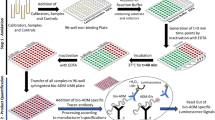Abstract
α-Amidation is a terminal modification in peptide biosynthesis that can itself be rate limiting in the overall production of bioactive α-amidated peptides. More than half of the known neural and endocrine peptides are α-amidated and in most cases this structural feature is essential for receptor recognition, signal transduction, and thus biologic function. This chapter describes methods for develo** and using analytical tools to study the biology of α-amidated peptides. The principal analytical method used to quantify α-amidated peptides is the radioimmunoassay (RIA). Detailed protocols are provided for (1) primary antibody production and characterization; (2) radiolabeling of RIA peptides; (3) sample preparation; and (4) performance of the RIA itself. Techniques are also described for the identification and verification of α-amidated peptides. Lastly, in vivo models used for studying the biology of α-amidation are discussed.
Access this chapter
Tax calculation will be finalised at checkout
Purchases are for personal use only
Similar content being viewed by others
References
Czyzyk TA, Ning Y, Hsu MS et al (2005) Deletion of peptide amidation enzymatic activity leads to edema and embryonic lethality in the mouse. Dev Biol 287:301–313
Eipper B, Stoffers D, Mains R (1992) The biosynthesis of neuropeptides: peptide α-amidation. Annu Rev Neurosci 15:57–85
Tsubaki M, Terashima I, Kamata K, Koga A (2013) C-terminal modification of monoclonal antibody drugs: amidated species as a general product-related substance. Int J Biol Macromol 52:139–147
Itoh S (2006) Mononuclear copper active-oxygen complexes. Curr Opin Chem Biol 10:115–122
Prigge ST, Mains RE, Eipper BA, Amzel LM (2000) New insights into copper monooxygenases and peptide amidation: structure, mechanism and function. Cell Mol Life Sci 57:1236–1259
Klinman JP (2006) The copper-enzyme family of dopamine beta-monooxygenase and peptidylglycine alpha-hydroxylating monooxygenase: resolving the chemical pathway for substrate hydroxylation. J Biol Chem 281:3013–3016
Kulathilia R, Merkler KA, Merkler DJ (1999) Enzymatic formation of C-terminal amides. Nat Prod Rep 16:145–154
An Z, Chen Y, Koomen JM, Merkler DJ (2012) A mass spectrometry-based method to screen for α-amidated peptides. Proteomics 12:173–182
Driscoll WJ, Mueller SA, Eipper BA, Mueller GP (1999) Differential regulation of peptide α-amidation by dexamethasone and disulfiram. Mol Pharm 55:1067–1076
Gstaiger M, Aebersold R (2009) Applying mass spectrometry-based proteomics to genetics, genomics and network biology. Nat Rev Genet 10:617–627
Walther TC, Mann M (2010) Mass spectrometry-based proteomics in cell biology. J Cell Biol 190:491–500
Gundry RL, White MY, Murray CI et al (2009) Preparation of proteins and peptides for mass spectrometry analysis in a bottom-up proteomics workflow. Curr Protoc Mol Biol Chapter 10:Unit 10.25
Mueller GP, Driscoll WJ, Eipper BA (1999) In vivo inhibition of peptidylglycine-α-hydroxylating monooxygenase by 4-phenyl-3-butenoic acid. J Pharmacol Exp Ther 290:1331–1336
Mueller G, Husten E, Mains R, Eipper B (1993) Peptide α-amidation and peptidylglycine-α-hydroxylating monooxygenase: control by disulfiram. Mol Pharm 44:972–980
Kolhekar AS, Roberts MS, Jiang N et al (1997) Neuropeptide amidation in Drosophila: separate genes encode the two enzymes catalyzing amidation. J Neurosci 17:1363–1376
Kuo YM, Zhou B, Cosco D, Gitschier J (2001) The copper transporter CTR1 provides an essential function in mammalian embryonic development. Proc Natl Acad Sci U S A 98:6836–6841
Steveson TC, Ciccotosto GD, Ma XM et al (2003) Menkes protein contributes to the function of peptidylglycine alpha-amidating monooxygenase. Endocrinology 144:188–200
Shiosaka S, Kiyama H, Wanaka A, Toyama M (1986) A new method for producing a specific and high titer antibody against glutamate using colloidal gold as carrier. Brain Res 382:399–403
Author information
Authors and Affiliations
Corresponding author
Editor information
Editors and Affiliations
Rights and permissions
Copyright information
© 2019 Springer Science+Business Media, LLC, part of Springer Nature
About this protocol
Cite this protocol
Mueller, G.P., Lazarus, R.C., Driscoll, W.J. (2019). α-Amidated Peptides: Approaches for Analysis. In: Kannicht, C. (eds) Post-Translational Modification of Proteins. Methods in Molecular Biology, vol 1934. Humana, New York, NY. https://doi.org/10.1007/978-1-4939-9055-9_16
Download citation
DOI: https://doi.org/10.1007/978-1-4939-9055-9_16
Published:
Publisher Name: Humana, New York, NY
Print ISBN: 978-1-4939-9053-5
Online ISBN: 978-1-4939-9055-9
eBook Packages: Springer Protocols




